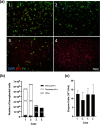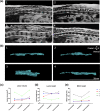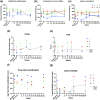Transplantation of encapsulated autologous olfactory ensheathing cell populations expressing chondroitinase for spinal cord injury: A safety and feasibility study in companion dogs
- PMID: 35686704
- PMCID: PMC9542194
- DOI: 10.1002/term.3328
Transplantation of encapsulated autologous olfactory ensheathing cell populations expressing chondroitinase for spinal cord injury: A safety and feasibility study in companion dogs
Abstract
Spinal cord injury (SCI) can cause irreversible paralysis, with no regenerative treatment clinically available. Dogs with natural SCI present an established model and can facilitate translation of experimental findings in rodents to people. We conducted a prospective, single arm clinical safety study in companion dogs with chronic SCI to characterize the feasibility of intraspinal transplantation of hydrogel-encapsulated autologous mucosal olfactory ensheathing cell (mOEC) populations expressing chondroitinase ABC (chABC). mOECs and chABC are both promising therapies for SCI, and mOECs expressing chABC drive greater voluntary motor recovery than mOECs alone after SCI in rats. Canine mOECs encapsulated in collagen hydrogel can be matched in stiffness to canine SCI. Four dogs with complete and chronic loss of function caudal to a thoraco-lumbar lesion were recruited. After baseline measures, olfactory mucosal biopsy was performed and autologous mOECs cultured and transduced to express chABC, then hydrogel-encapsulated and percutaneously injected into the spinal cord. Dogs were monitored for 6 months with repeat clinical examinations, spinal MRI, kinematic gait and von Frey assessment. No adverse effects or significant changes on neurological examination were detected. MRI revealed large and variable lesions, with no spinal cord compression or ischemia visible after hydrogel transplantation. Owners reported increased pelvic-limb reflexes with one dog able to take 2-3 unsupported steps, but gait-scoring and kinematic analysis showed no significant improvements. This novel combination approach to regeneration after SCI is therefore feasible and safe in paraplegic dogs in a clinical setting. A randomised-controlled trial in this translational model is proposed to test efficacy.
Keywords: canine translational model; cell therapy / transplantation; chondroitinase ABC; hydrogel encapsulation; neurology; neuroscience; olfactory ensheathing cells; spinal cord injury; spontaneous animal model.
© 2022 The Authors. Journal of Tissue Engineering and Regenerative Medicine published by John Wiley & Sons Ltd.
Conflict of interest statement
The authors declare no conflicts of interests.
Figures



Similar articles
-
Delivery of chondroitinase by canine mucosal olfactory ensheathing cells alongside rehabilitation enhances recovery after spinal cord injury.Exp Neurol. 2021 Jun;340:113660. doi: 10.1016/j.expneurol.2021.113660. Epub 2021 Feb 26. Exp Neurol. 2021. PMID: 33647272
-
Canine olfactory ensheathing cells from the olfactory mucosa can be engineered to produce active chondroitinase ABC.J Neurol Sci. 2016 Aug 15;367:311-8. doi: 10.1016/j.jns.2016.06.011. Epub 2016 Jun 4. J Neurol Sci. 2016. PMID: 27423610
-
Effect of the combination of mesenchymal stromal cells and chondroitinase ABC on chronic spinal cord injury.Cytotherapy. 2015 Oct;17(10):1374-83. doi: 10.1016/j.jcyt.2015.05.012. Epub 2015 Jul 15. Cytotherapy. 2015. PMID: 26188966
-
Combination treatment with chondroitinase ABC in spinal cord injury--breaking the barrier.Neurosci Bull. 2013 Aug;29(4):477-83. doi: 10.1007/s12264-013-1359-2. Epub 2013 Jul 9. Neurosci Bull. 2013. PMID: 23839053 Free PMC article. Review.
-
Targeting Translational Successes through CANSORT-SCI: Using Pet Dogs To Identify Effective Treatments for Spinal Cord Injury.J Neurotrauma. 2017 Jun 15;34(12):2007-2018. doi: 10.1089/neu.2016.4745. Epub 2017 Mar 22. J Neurotrauma. 2017. PMID: 28230415 Free PMC article. Review.
Cited by
-
Pathophysiology and Therapeutic Approaches for Spinal Cord Injury.Int J Mol Sci. 2022 Nov 10;23(22):13833. doi: 10.3390/ijms232213833. Int J Mol Sci. 2022. PMID: 36430308 Free PMC article. Review.
-
Approach to Small Animal Neurorehabilitation by Locomotor Training: An Update.Animals (Basel). 2022 Dec 18;12(24):3582. doi: 10.3390/ani12243582. Animals (Basel). 2022. PMID: 36552502 Free PMC article. Review.
-
Chondroitinase ABC in spinal cord injury: advances in delivery strategies and therapeutic synergies.Front Bioeng Biotechnol. 2025 Jun 9;13:1604502. doi: 10.3389/fbioe.2025.1604502. eCollection 2025. Front Bioeng Biotechnol. 2025. PMID: 40552113 Free PMC article. Review.
References
-
- Bakker, M. H. , Tseng, C. C. S. , Keizer, H. M. , Seevinck, P. R. , Janssen, H. M. , Van Slochteren, F. J. , Chamuleau, S. A. J. , & Dankers, P. Y. W. (2018). MRI visualization of injectable ureidopyrimidinone hydrogelators by supramolecular contrast agent labeling. Advanced Healthcare Materials, 7(11), 1701139. 10.1002/adhm.201701139 - DOI - PubMed
-
- Fawcett, J. W. , Curt, A. , Steeves, J. D. , Coleman, W. P. , Tuszynski, M. H. , Lammertse, D. , Lammertse, D. , Blight, A. R. , Dietz, V. , Ditunno, J. , Dobkin, B. H. , Havton, L. A. , Ellaway, P. H. , Fehlings, M. G. , PrivAt, A. , GRossman, R. , Guest, J. D. , Kleitma, N. N. , NakaMura, M. , …, & Short, D. (2007). Guidelines for the conduct of clinical trials for spinal cord injury as developed by the ICCP panel: Spontaneous recovery after spinal cord injury and statistical power needed for therapeutic clinical trials. Spinal Cord, 45(3), 190–205. 10.1038/sj.sc.3102007 - DOI - PubMed
Publication types
MeSH terms
Substances
LinkOut - more resources
Full Text Sources
Medical

